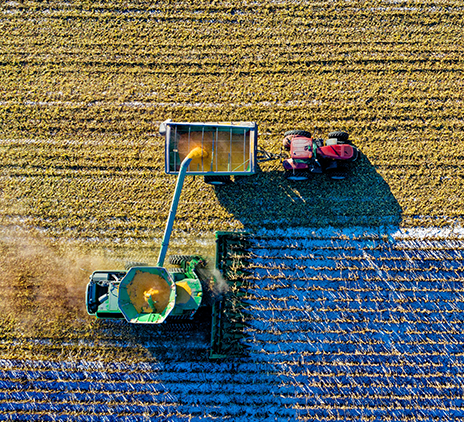- Market services
- Indigenous advisory
-
Compliance audits & reviews
Our audit team undertakes the complete range of audits required of Australian accounting laws to help you to help you meet obligations or fulfil best practice procedures.
-
Audit quality
We are fiercely dedicated to quality, use proven and globally tested audit methodologies, and invest in technology and innovation.
-
Financial reporting advisory
Our financial reporting advisory team helps you understand changes in accounting standards, develop strategies and communicate with your stakeholders.
-
Audit advisory
Grant Thornton’s audit advisory team works alongside our clients, providing a full range of reviews and audits required of your business.

-
Corporate tax & advisory
We provide comprehensive corporate tax and advisory service across the full spectrum of the corporate tax process.
-
Private business tax & advisory
We work with private businesses and their leaders on all their business tax and advisory needs.
-
Tax compliance
We work alongside clients to manage all tax compliance needs and identify potential compliance or tax risk issues.
-
Employment tax
We help clients understand and address their employment tax obligations to ensure compliance and optimal tax positioning for their business and employees.
-
International tax
We understand what it means to manage tax issues across multiple jurisdictions, and create effective strategies to address complex challenges.
-
GST, stamp duty & indirect tax
Our deep technical knowledge and practical experience means we can help you manage and minimise the impact of GST and indirect tax, like stamp duty.
-
Tax law
Our team – which includes tax lawyers – helps you understand and implement regulatory requirements for your business.
-
Innovation Incentives
Our national team has extensive experience navigating all aspects of the government grants and research and development tax incentives.
-
Transfer pricing
Transfer pricing is one of the most challenging tax issues. We help clients with all their transfer pricing requirements.
-
Tax digital consulting
We analyse high-volume and unstructured data from multiple sources from our clients to give them actionable insights for complex business problems.
-
Corporate simplification
We provide corporate simplification and managed wind-down advice to help streamline and further improve your business.
-
Superannuation and SMSF
Increasingly, Australians are seeing the benefits, advantages and flexibility of taking control of their own superannuation and retirement planning.

-
Payroll consulting & Award compliance
Many organisations are grappling with a myriad of employee agreements and obligations, resulting in a wide variety of payments to their people.
-
Cyber resilience
The spectrum of cyber risks and threats is now so significant that simply addressing cybersecurity on its own isn’t enough.
-
Internal audit
We provide independent oversight and review of your organisation's control environments to manage key risks, inform good decision-making and improve performance.
-
Financial crime
Our team helps clients navigate and meet their obligations to mitigate crime as well as develop and implement their risk management strategies.
-
Consumer Data Right
Consumer Data Right (CDR) aims to provide Australians with more control over how their data is used and disclosed.
-
Risk management
We enable our clients to achieve their strategic objectives, fulfil their purpose and live their values supported by effective and appropriate risk management.
-
Controls assurance
In Australia, as with other developed economies, regulatory and market expectations regarding corporate transparency continue to increase.
-
Governance
Through fit for purpose governance we enable our clients to make the appropriate decisions on a timely basis.
-
Regulatory compliance
We enable our clients to navigate and meet their regulatory and compliance obligations.

-
Forensic accounting and dispute advisory
Our team advises at all stages of a litigation dispute, taking an independent view while gathering and reviewing evidence and contributing to expert reports.
-
Investigations
Our licensed forensic investigators with domestic and international experience deliver high quality results in the jurisdictions in which you operate.
-
Digital forensics
Our digital forensic experts identify, preserve and analyse data in the context of reputation and regulatory enforcement issues for investigations, legal or administrative proceedings.
-
eDiscovery
In a data-driven economy, data enables commercial and economic growth, innovation, and social benefit.
-
Asset tracing investigations
Our team of specialist forensic accountants and investigators have extensive experience in tracing assets and the flow of funds.

-
Mergers and acquisitions
Our mergers and acquisitions specialists guide you through the whole process to get the deal done and lay the groundwork for long-term success.
-
Acquisition search & strategy
We help clients identify, finance, perform due diligence and execute acquisitions to maximise the growth opportunities of your business.
-
Selling a business
Our M&A team works with clients to achieve a full or partial sale of their business, to ensure achievement of strategic ambitions and optimal outcomes for stakeholders.
-
Operational deal services
Our operational deal services team helps to ensure the greatest possible outcome and value is gained through post merger integration or post acquisition integration.
-
Transaction advisory
Our transaction advisory services support our clients to make informed investment decisions through robust financial due diligence.
-
Business valuations
We use our expertise and unique and in-depth methodology to undertake business valuations to help clients meet strategic goals.
-
Tax in mergers & acquisition
We provide expert advice for all M&A taxation aspects to ensure you meet all obligations and are optimally positioned.

-
Corporate finance
We provide effective and strategic corporate finance services across all stages of investments and transactions so clients can better manage costs and maximise returns.
-
Debt advisory
We work closely with clients and lenders to provide holistic debt advisory services so you can raise or manage existing debt to meet your strategic goals.
-
Working capital optimisation
Our proven methodology identifies opportunities to improve your processes and optimise working capital, and we work with to implement changes and monitor their effectiveness.
-
Capital markets
Our team has significant experience in capital markets and helps across every phase of the IPO process.
-
Debt and project finance raising
Backed by our experience accessing full range of available funding types, we work with clients to develop and implement capital raising strategies.
-
Private equity
We provide advice in accessing private equity capital.
-
Financial modelling
Our financial modelling advisory team provides strategic, economic, financial and valuation advice for project types and sizes.
-
Payments advisory
We provide merchants-focused payments advice on all aspects of payment processes and technologies.

-
Voluntary administration & DOCA
We help businesses considering or in voluntary administration to achieve best possible outcomes.
-
Corporate insolvency & liquidation
We help clients facing corporate insolvency to undertake the liquidation process to achieve a fair and orderly company wind up.
-
Complex and international insolvency
As corporate finance specialists, Grant Thornton can help you with raising equity, listings, corporate structuring and compliance.
-
Safe Harbour advisory
Our Safe Harbour Advisory helps directors address requirements for Safe Harbour protection and business turnaround.
-
Bankruptcy and personal insolvency
We help clients make informed choices around bankruptcy and personal insolvency to ensure the best personal and stakeholder outcome.
-
Creditor advisory services
Our credit advisory services team works provides clients with credit management assistance and credit advice to recapture otherwise lost value.
-
Small business restructuring process
We provide expert advice and guidance for businesses that may need to enter or are currently in small business restructuring process.
-
Asset tracing investigations
Our team of specialist forensic accountants and investigators have extensive experience in tracing assets and the flow of funds.

-
Independent business reviews
Does your company need a health check? Grant Thornton’s expert team can help you get to the heart of your issues to drive sustainable growth.
-
Commercial performance
We help clients improve commercial performance, profitability and address challenges after internal or external triggers require a major business model shift.
-
Safe Harbour advisory
Our Safe Harbour advisory helps directors address requirements for Safe Harbour protection and business turnaround.
-
Corporate simplification
We provide corporate simplification and managed wind-down advice to help streamline and further improve your business.
-
Director advisory services
We provide strategic director advisory services in times of business distress to help directors navigate issues and protect their company and themselves from liability.
-
Debt advisory
We work closely with clients and lenders to provide holistic debt advisory services so you can raise or manage existing debt to meet your strategic goals.

-
Business planning & strategy
Our clients can access business planning and strategy advice through our value add business strategy sessions.
-
Private business company secretarial services
We provide company secretarial services and expert advice for private businesses on all company secretarial matters.
-
Outsourced accounting services
We act as a third-party partner to international businesses looking to invest in Australia on your day-to-day finance and accounting needs.
-
Superannuation and SMSF
We provide SMSF advisory services across all aspects of superannuation and associated tax laws to help you protect and grow your wealth.
-
Management reporting
We help you build comprehensive management reporting so that you have key insights as your business grows and changes.
-
Financial reporting
We help with all financial reporting needs, including set up, scaling up, spotting issues and improving efficiency.
-
Forecasting & budgeting
We help you build and maintain a business forecasting and budgeting model for ongoing insights about your business.
-
ATO audit support
Our team of experts provide ATO audit support across the whole process to ensure ATO requirements are met.
-
Family business consulting
Our family business consulting team works with family businesses on running their businesses for continued future success.
-
Private business taxation and structuring
We help private business leaders efficiently structure their organisation for optimal operation and tax compliance.
-
Outsourced CFO services
Our outsourced CFO services provide a full suite of CFO, tax and finance services and advice to help clients manage risk, optimise operations and grow.
-
ESG & sustainability reporting
There is a growing demand for organisations to provide transparency on their commitment to sustainability and disclosure of the nonfinancial impacts of their business activities. Commonly, the responsibility for sustainability and ESG reporting is landing with CFOs and finance teams, requiring a reassessment of a range of reporting processes and controls.
-
ESG & sustainability advisory
With the ESG and sustainability landscape continuing to evolve, we are focussed on helping your business to understand what ESG and sustainability represents and the opportunities and challenges it can provide.

-
Management consulting
Our management consulting services team helps you to plan and implement the right strategy to deliver sustainable growth.
-
Financial consulting
We provide financial consulting services to keep your business running so you focus on your clients and reaching strategic goals.

-
China practice
The investment opportunities between Australia and China are well established yet, in recent years, have also diversified.
-
Japan practice
The trading partnership between Japan and Australia is long-standing and increasingly important to both countries’ economies.
-
India practice
It’s an exciting time for Indian and Australian businesses looking to each jurisdiction as part of their growth ambitions.
-
Singapore practice
Our Singapore Practice works alongside Singaporean companies to achieve growth through investment and market expansion into Australia.

-
 Insight Identify your opportunities in the complex landscape of fuel tax creditsThe landscape of fuel tax credits (FTC) is constantly evolving due to ongoing economic and technological developments. This dynamic environment presents both challenges and opportunities for businesses with significant fuel consumption.
Insight Identify your opportunities in the complex landscape of fuel tax creditsThe landscape of fuel tax credits (FTC) is constantly evolving due to ongoing economic and technological developments. This dynamic environment presents both challenges and opportunities for businesses with significant fuel consumption. -
 Client Alert March 2024 Update: NSW Grants for Net Zero Manufacturing and Physical SciencesSome major NSW grant programs have been announced, supporting projects in clean technology innovation, low carbon product manufacturing, renewable manufacturing and physical sciences.
Client Alert March 2024 Update: NSW Grants for Net Zero Manufacturing and Physical SciencesSome major NSW grant programs have been announced, supporting projects in clean technology innovation, low carbon product manufacturing, renewable manufacturing and physical sciences. -
 Insight Navigating a complex Agribusiness, Food and Beverage deals landscape in 2024Despite a 14% global decline in Agribusiness, Food, and Beverage M&A deals, 2024 shows promise with expected global interest rate stabilisation. Given the sector's role in global sustainability, businesses can tap into opportunities in food manufacturing and waste minimisation.
Insight Navigating a complex Agribusiness, Food and Beverage deals landscape in 2024Despite a 14% global decline in Agribusiness, Food, and Beverage M&A deals, 2024 shows promise with expected global interest rate stabilisation. Given the sector's role in global sustainability, businesses can tap into opportunities in food manufacturing and waste minimisation. -
 Client Alert Grants: February 2024Businesses should be aware of the numerous grant opportunities available from Commonwealth, State, and private sources. These grants could be the key to making manufacturing, agriculture, and green economy projects a reality.
Client Alert Grants: February 2024Businesses should be aware of the numerous grant opportunities available from Commonwealth, State, and private sources. These grants could be the key to making manufacturing, agriculture, and green economy projects a reality.
-
Renewable Energy
Transformation through energy transition

-
Business Planning and Strategy
Having an honest, broad-reaching and thought-provoking discussion with a skilled, independent advisor can be the catalyst for clarity – a direction to take your business forward and an understanding of what is key to success.

-
Flexibility & benefits
The compelling client experience we’re passionate about creating at Grant Thornton can only be achieved through our people. We’ll encourage you to influence how, when and where you work, and take control of your time.
-
Your career development
At Grant Thornton, we strive to create a culture of continuous learning and growth. Throughout every stage of your career, you’ll to be encouraged and supported to seize opportunities and reach your full potential.
-
Diversity & inclusion
To be able to reach your remarkable, we understand that you need to feel connected and respected as your authentic self – so we listen and strive for deeper understanding of what belonging means.
-
In the community
We’re passionate about making a difference in our communities. Through our sustainability and community engagement initiatives, we aim to contribute to society by creating lasting benefits that empower others to thrive.
-
Graduate opportunities
As a new graduate, we aim to provide you more than just your ‘traditional’ graduate program; instead we kick start your career as an Associate and support you to turn theory into practice.
-
Vacation program
Our vacation experience program will give you the opportunity to begin your career well before you finish your degree.
-
The application process
Applying is simple! Find out more about each stage of the recruitment process here.
-
FAQs
Got questions about applying? Explore frequently asked questions about our early careers programs.
-
Our services lines
Learn about our services at Grant Thornton
-
Current opportunities
Current opportunities
-
Remarkable people
Our team members share their remarkable career journeys and experiences of working at Grant Thornton.
-
Working at Grant Thornton
Explore our culture, benefits and ways we support you in your career.
-
Current opportunities
Positions available.
-
Contact us
Get in touch

Now, with the Modern Manufacturing Initiative’s Food & Beverage Roadmap steering investment into automation and digitisation, things like smart waste management (costing Australia $20b a year) and digital provenance (to prevent issues like counterfeit wine) will make Australia leaders in this emerging field.
In our latest podcast, Tony Pititto, National Head of Agribusiness, Food & Beverage at Grant Thornton and Madina Aziz, Audit Partner discuss the opportunities for the sector through the Modern Manufacturing Initiative and what we need next from Government to help Australia target non-traditional export markets. This is much broader than simply processed food – we’re talking better quality products, reducing waste, and innovative ways of bringing products to new markets and customers.
Available on Apple Podcasts, Spotify or within your browser
Therese Raft
Welcome to Navigating the New Normal – Grant Thornton’s podcast exploring trends in business and the marketplace.
I’m Therese Raft and I am joined by Tony Pititto, National Head of Agribusiness, Food & Beverage at Grant Thornton and Madina Aziz, Audit Partner with a range of food and beverage clients. Today we’re talking modern manufacturing and the food and beverage 10 year roadmap, an exciting opportunity to help propel Australian produce into the global marketplace.
Welcome Tony and Madina!
Tony Pititto
Thanks Therese and hello Madina.
Madina Aziz
Thanks Therese. Hi Tony.
Therese Raft
So the Modern Manufacturing Initiative has been careful to select areas of opportunity that were already areas of strength for Australia. Now, we already have an amazing reputation for food, don’t we?
Tony Pititto
Absolutely. Look, Australia's got a really a great international reputation for the produce that we produce. It's green and clean, and we command premium on international markets. Not only internationally, but also in Australia. And we are fortunate we are close to… we have close proximity to the Asian market. We are very much a trusted exporter and despite the glitches that we're experiencing in a few areas with our exports into China – it also gives the Australian producers, I think, an opportunity to diversify into new international markets. And you know, Australian manufacturers have really shown during COVID that they can be agile producers. And they've demonstrated a significant resilience during this period. And have been able to, I guess, pivot into other, different areas to keep the Australian economy really growing.
Madina Aziz
I think, yeah, agree we definitely have a competitive advantage in food exports. We have ideal climate and soil to produce a wide variety of quality, fresh food pretty much year ‘round. But there's also a significant amount of processed and value added food that we're famous for. Things like cereal, muesli, oats, nuts, organic food and other health foods. I think we typically associate our famous foods with the beef, our wines and so forth. So there's a lot of other areas that we are also quite well known for in the world. But there's still so much opportunity that can be leveraged off the good reputation that we have, so not only in value adding to the basic commodity foods we supply the world, but also tapping into new markets, as Tony mentioned.
Therese Raft
That’s a really good segue, because what I find really interesting about the roadmap is that they consistently talk about innovation, automation, digitisation, data analytics – very much associated with the processed foods. But that all very much sounds like, I guess, sugary foods, processed foods, fast foods?
Madina Aziz
I think you're right, Therese. I think when we instantly think those terms, we think about manufactured foods and associated capital expenditure. But it's a lot broader than that. It's about producing better quality product, establishing quicker delivery times, reducing waste. But it could even be bringing products, processes and designs to new and existing markets or value chains and customers. I mean, I recently had a client who manufactures a perishable product. Roughly has a three day shelf life. And when we were discussing the initiative, they thought they had missed the boat because they'd already spent quite a bit of money on a new state-of-the-art automated plant facility / plant line. But when we discussed what they're doing over the next 6 to 9 months, we uncovered that they were redesigning their product to extend its shelf life and considering frozen options as well as redesigning their packaging or individual packaging, and this was specifically undertaken to supply to a very large Australian customer, and that's a perfect example of innovation.
Tony Pititto
Yeah, that's a really good point, Madina. And I think you know another example of the innovation could be looking at provenance in terms of where the food comes from. And, you know, one particular area where this is important for instance, is in wine. And you know, we frequently have the situation where Australian, you know, overseas, where wine is deemed to be Australian - but in fact, it has been counterfeited as not Australian wine. And so the new technology, new innovation can help produces underpin the provenance of Australian wine because it's got a fantastic reputation overseas and we want to be able to protect that.
Therese Raft
That’s fascinating. I think many of us wouldn't assume that there'd be counterfeit wine floating around. Now, the vision is to double the value of Australia’s Food & Beverage manufacturing by 2030 – is that doable? And is it doable because we have a low base to build from?
Tony Pititto
Well, it is absolutely doable, and there are a number of ingredients that help underpin this. And Australia's exports have already been growing. And manufacturing has already been growing, so it's not as if it hasn't been growing recently. But you know, we have the necessary ingredients. As I mentioned the world's population, it’s expected to grow to 9.8 billion by 2050 so the demand is there. The food manufacturing sector is also closely aligned with the agricultural industry, which is aiming to increase its farm output to $100 billion by 2030. So that's, you know, 5% to 6% compound growth rate. Also, you know, food and beverage manufacturing in Australia is the single largest manufacturing sector, which accounts for about 28% of all manufacturing turnover in Australia. So absolutely doable. We have the ingredients and it’s very much so an achievable target.
Madina Aziz
I agree with Tony here. It's definitely doable and there's plenty of opportunity. And as we mentioned, particularly in the value add sectors. We have access to the raw materials. We have access to really great manufacturing capability across the country. So we've got some really good assets in Australia that we haven't fully tapped into. And on top of that, almost all the players are SMEs, so it's quite fragmented at the moment and operates in silos with a lot of duplication. And the sector can really excel here because value adding in Australia will actually generate a higher return and create more jobs.
Therese Raft
Now, I’m still trying to wrap my head around this, so perhaps you can help me a little bit. When the Government talks about incubation hubs and access to large scale end-to-end production facilities, does the sector, which as you say – many SME’s, very fragmented – do they really want to collaborate when they are so different and there are perhaps competitive advantages in going alone?
Tony Pititto
Well, look, integration and collaboration certainly has been difficult for the sector, given that you know, you have many diverse business types – as you've spoken about – many SMEs that make up the sector. So there are certainly definitely competitive advantages by going alone. But they're also benefits of scale that comes from collaboration, which would certainly lower production costs and improve efficiency. But it's important to understand that collaboration really can happen on a number of fronts within the sector. You know, collaboration could entail having access to pilot plants to test new products and the state-of-the-art equipment before undertaking significant investment that's required at an SME level. Collaboration could also be at the tertiary sector, where education skills required for the food & beverage sector are being met. It could come from government so that policy and regulatory settings for agriculture and food and beverage are aligned and centred within one Department. And it could also… collaboration could also be in Australia's regional levels by building a region's capability, its capacity and business, confidence to invest, innovate and scale-up. So there are a number of different ways collaboration can help in the sector.
Madina Aziz
I think Tony, a good example of that is the CSIRO who have been doing this sort of work assisting with food innovation for SMEs for a number of years. And some of their success stories has been around food production using significantly less amount of energy than normally required. Developing alternate cooking techniques as opposed to heat that extends shelf life, kills bacteria, moulds and, yeast, and so forth in fresh fruit and veggies. Or even developing alternate chilling methods or freezing methods; using spray chilling, for example, which doesn't compromise shelf life. So it's definitely been happening and I think the key is encouraging more of that innovation and collaboration.
Therese Raft
Wow, that's a lot of work that's going into our food! Now as a sector, it really is all about the trends in the marketplace and being able or being agile to respond to these trends. Is a smart food and beverage sector really going to be more able to respond more swiftly to those trends?
Madina Aziz
Absolutely. The more data and real time insight you have, the faster you can respond. And this is particularly true when you're tapping into international markets, when you're much further away from your product and even your customers. So businesses understanding what is selling, what isn't selling where it's selling. It really tells you something about where to refocus or focus your product development. And to do that, you actually need to have smart manufacturing as well as automation to reduce errors, enhancing product shelf life, supporting changes to packaging and reducing food waste.
Tony Pititto
Thanks, Madina. Look, I think the other benefit of being able to respond more quickly and you've touched upon this is reducing food waste, which is a significant problem not only in Australia but globally. You know, Australians waste about $20 billion per annum in food waste, or about 7.3 million tonnes per annum. So that's about 300 kg per person that we waste, which is about one in five bags of shopping, I guess. So, you know, by being able to respond more quickly and being able to produce the right food where consumers want that, and when they want that, then this is a great opportunity to be able to reduce, you know, the waste. And it's not only food. Packaging, as well. Australians throw away 1.9 billion tonnes of packaging per annum. Now, most of that would be in the food production area. Really, the numbers speak for themselves.
Therese Raft
Those are really staggering numbers, Tony. And is a really nice kind of segue into the next question I have, which is around supply chain. Because, I suppose in the wake of COVID, I think we can all very much agree that supply chain resilience is a very welcome addition to the food and beverage roadmap.
Tony Pititto
Yeah, well, certainly COVID – what it did show is that it did have a significant impact and really did disrupt not only the local supply chain, but also global supply chains, and movements within Australia. So we all saw that when the borders were shut. So I think this is an area that does require some assistance from the Government. And the Government has already commenced that by, I guess through its Government supply chain resilience initiative. So this is really a step in the right direction which, you know… This process looks to map and analyse where are our vulnerabilities, where are the opportunities in Australia's food and beverage factory supply chain? And how do we address those – you know – those opportunities or those weak spots within the supply chain?
Madina Aziz
I think I agree with Tony as well. When you have a combination of the labour restrictions, raw material or import sourcing constraints, plant and border closures, coupled with panic buying, for example, this put enormous pressure on the industry. And I mean, I certainly remember when canned vegetables and mincemeat were out of stock for weeks during the peak of the pandemic. So what we did learn was there were a lot of gaps in the supply chain and particularly these were around transportation, logistics, procurement and monitoring technologies. But I think it's important to highlight as part of the initiative, it's not only about building Australia's resilience and our agility, but it's also about domestic manufacturers playing an important role in global supply chains as well – and helping other countries meet their needs. So positioning us in Australia as a reliable supplier of quality products, Australia can take a real important role in helping solve global supply chain issues which naturally will flow onto our economy.
Therese Raft
That's a really good point for us all to remember. It's not just about the domestic supply chain. Now there's something that hasn't been touched on in the road map. But I'm sure anyone who buys groceries will be thinking about this. With an investment of the scale – even with government support – this will surely have a flow on to the consumers’ hip pocket.
Madina Aziz
Not necessarily, Therese. I mean, there's a number of things that influence the cost of food: cost of labour, seasonality, weather events. I mean investments should improve manufacturing efficiencies and costs in the long term, which help the stability and would ultimately allow food and beverage manufacturers to focus more on their customers. What they want, how they want it, better quality, fresher, faster. And of course, we've talked a lot about reducing waste, as well. And these large scale investments are usually viewed over the long term and not your typical 2 to 3 pay back periods, so the flow on effect is not necessarily exponential to the customer's pocket.
Tony Pititto
Thanks, Madina. Look, there's some really good points there. I think also, you know the Government's incentives to try and create food hubs – well, that's a way that you can reduce costs and share those costs across a number of manufacturers. And also, we need to remember that Australian produce and products do command a premium. We’re not the cheapest products, but we are the highest quality, and consumers are willing to spend a little bit more for excellent quality food.
Therese Raft
Now there's a lot of stuff happening, and this is all very much influenced by policy. And policy changes have in fact, been put on the agenda as an item to address in the next two years under this road map. What policies spring to mind that need to change to help support the vision for a thriving food and beverage manufacturing sector.
Tony Pititto
Look, I think the greatest or the most urgent issue that needs to be tackled is labour availability and flexibility. With the international borders being closed this is going to require some rethinking in terms of …ensuring that labour is available, not only in the regional areas. We've all heard about, you know, the lack of available labour in regional areas to pick our fruit and vegetables. But it's also within manufacturing. A number of manufacturing clients, including some of my clients, are experiencing real problems in being able to source labour. So I think that really does need to be tackled as a matter of urgency. I think the other area that does need focus on is, you know, we spoke about smart manufacturing and new technology manufacturing hubs. Well, that's going to require labour to be trained into these new manufacturing technologies and methods. So the training for our manufacturing sector really does need to be addressed so that it is state-of-the-art and is available for the sector. I think the other area that the government can assist is perhaps providing more support to our manufacturers to understand the non-traditional export markets. I mean, we've all read about the recent China trade issues. What it does show is that we do need to diversify, and so the Government's assistance here is really needed to help our SME’s take advantage of the non-traditional export markets. And look, you know, I think Government's done an excellent job over the last few years in terms of promoting the Free Trade Agreements. And I think, you know, that aspect really shows that it can have a positive impact on the sector.
Madina Aziz
I think Tony, a good example of non-traditional export markets is the current UK Free Trade Agreement, which is expected to be finalised in the next few months, which is definitely a step in the right direction by the Government and would be very beneficial to the food and beverage sector. At the moment our largest exports into the UK have been beef and wine, but it will open up a lot more for F&B broadly – for food and beverage broadly – particularly in other agricultural sectors, fruit and vegetables, dairy, cereal and grains, which we're already famous for. It will also be interesting to see how Australia and India agreements… which is set to recommence when negotiations were suspended back in 2015. A huge sticking point was around agriculture because half of India's employment is linked to that sector, and it's our biggest export. So it will be very interesting to see how this plays out.
Therese Raft
It's really interesting that you're talking about the UK because I think a lot of people would have thought “wow, trying to get fresh produce to the – literally the – other side of the world would have been quite a mean feat. So it'll certainly be interesting to see how that all pans out.
Well, Tony and Madina, thank you so much for your time. If I can put you both on the spot, are you both contactable on LinkedIn, email, phone if anyone would like to get in touch to talk more about the MMI and, or, the food and beverage sector?
Tony Pititto
Absolutely, Therese. You know, I’m on LinkedIn. And I’m really passionate about the sector so looking forward to having a chat to those that are interested.
Madina Aziz
Agree with Tony there, thanks Therese. Definitely contactable on LinkedIn, email or phone. So if you want to have a deeper conversation around the MMI or food and beverage sector, please feel free to reach out.
Therese Raft
Wonderful. Thank you so much, both.
Tony Pititto
Thanks Therese, thanks Madina.
Madina Aziz
Thanks, Tony.
Therese Raft
If you liked this podcast and would like to hear more, you can find and subscribe to Grant Thornton Australia on Apple Podcasts or Spotify.


































